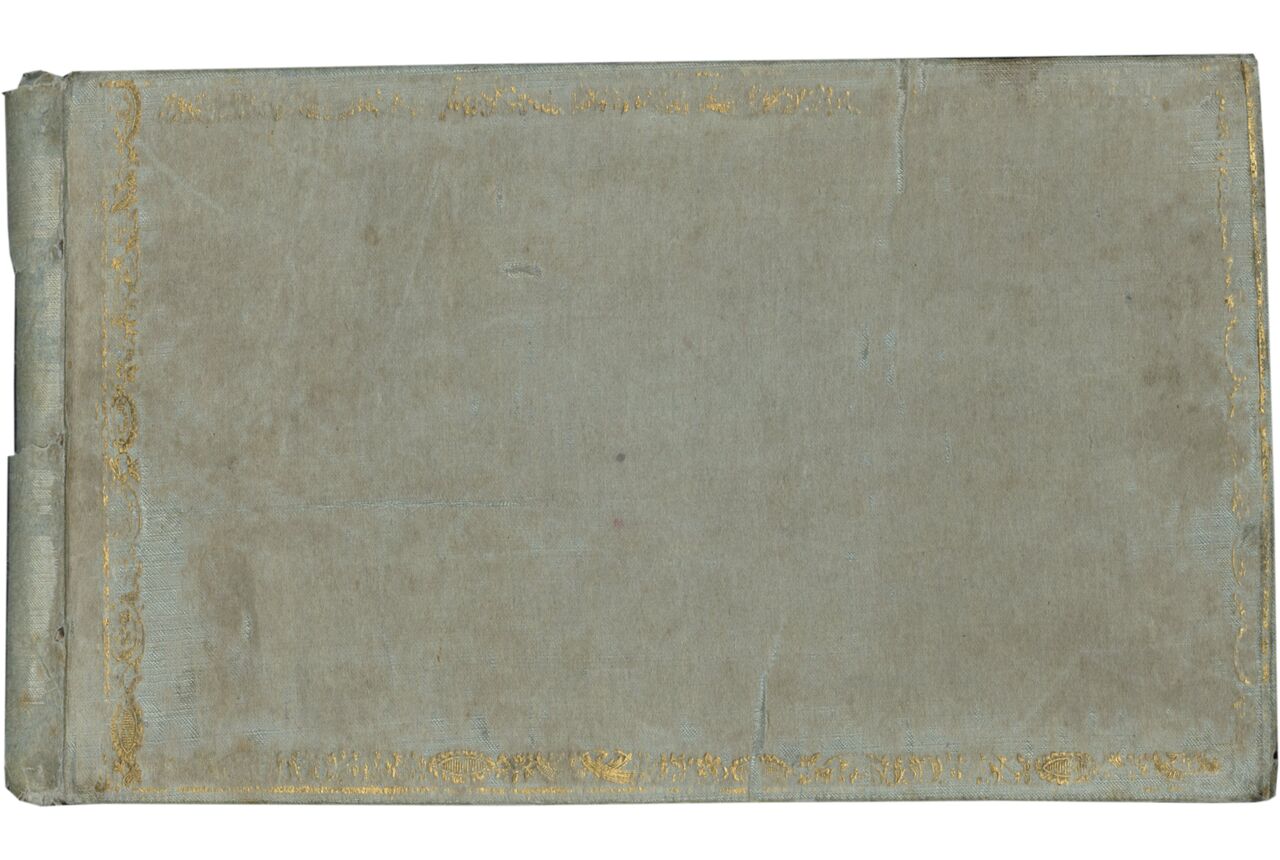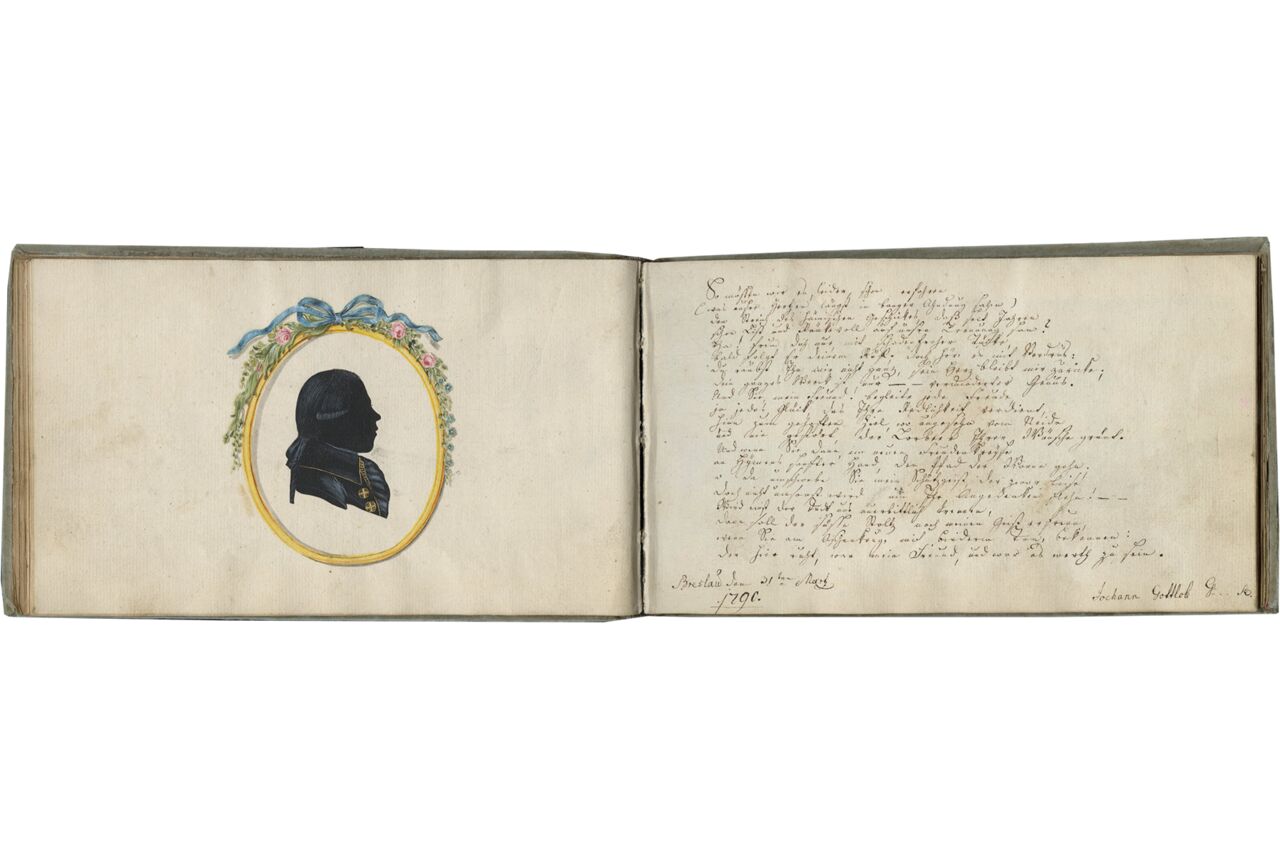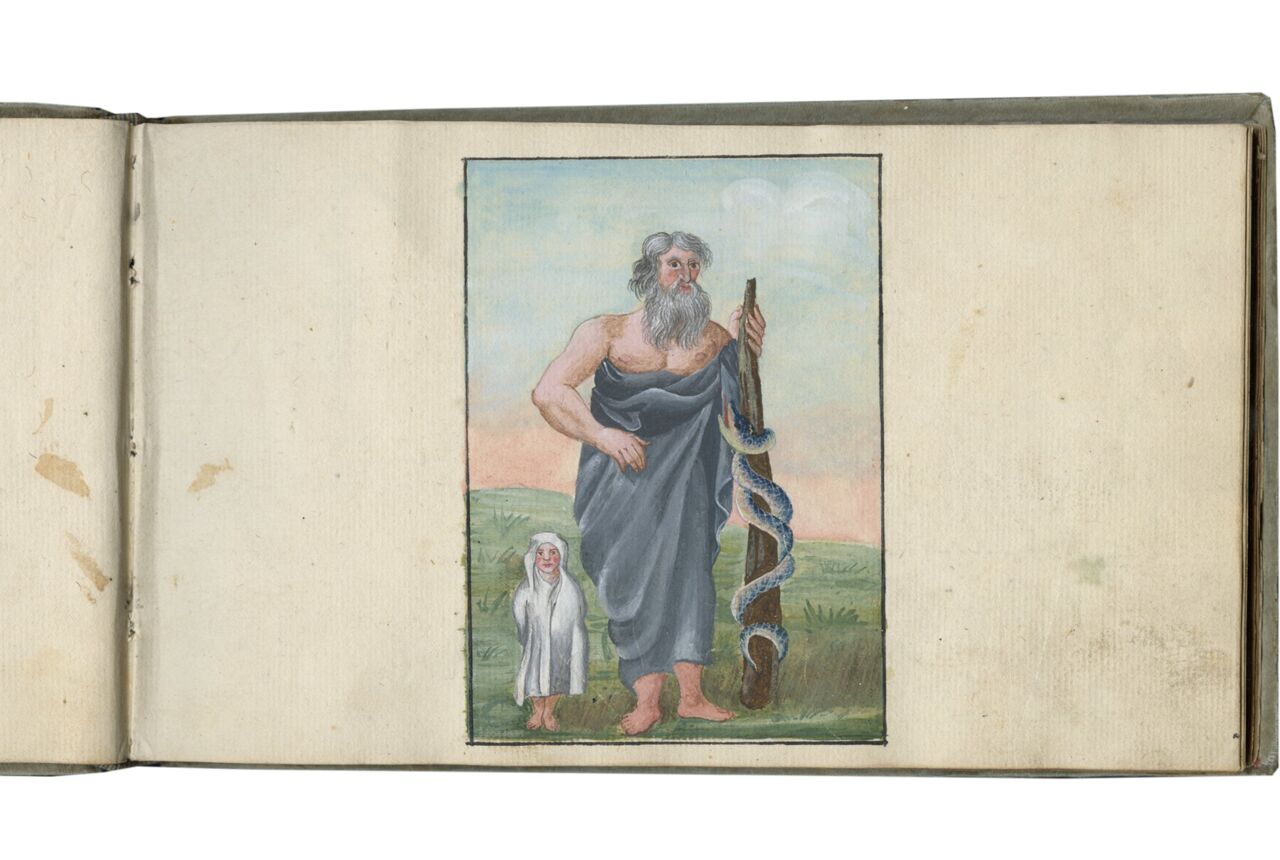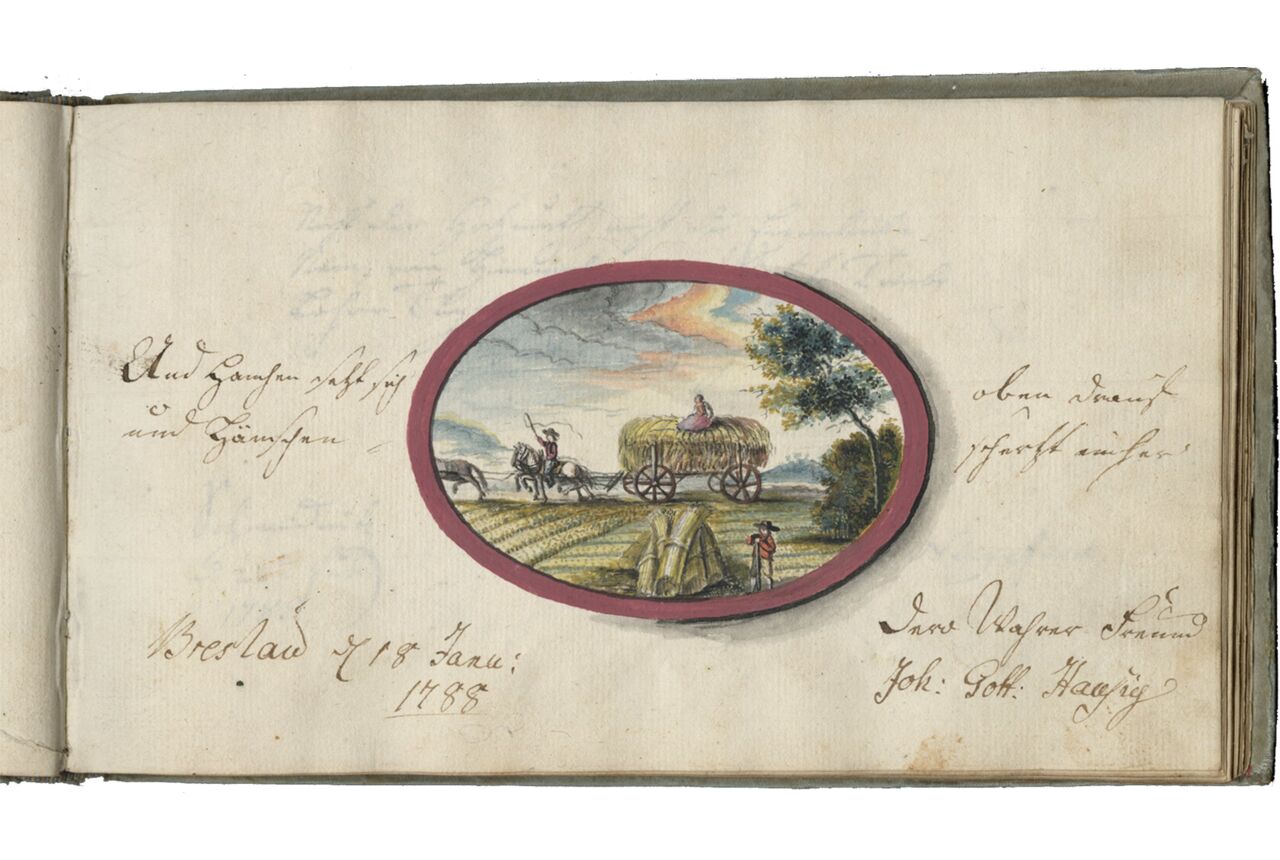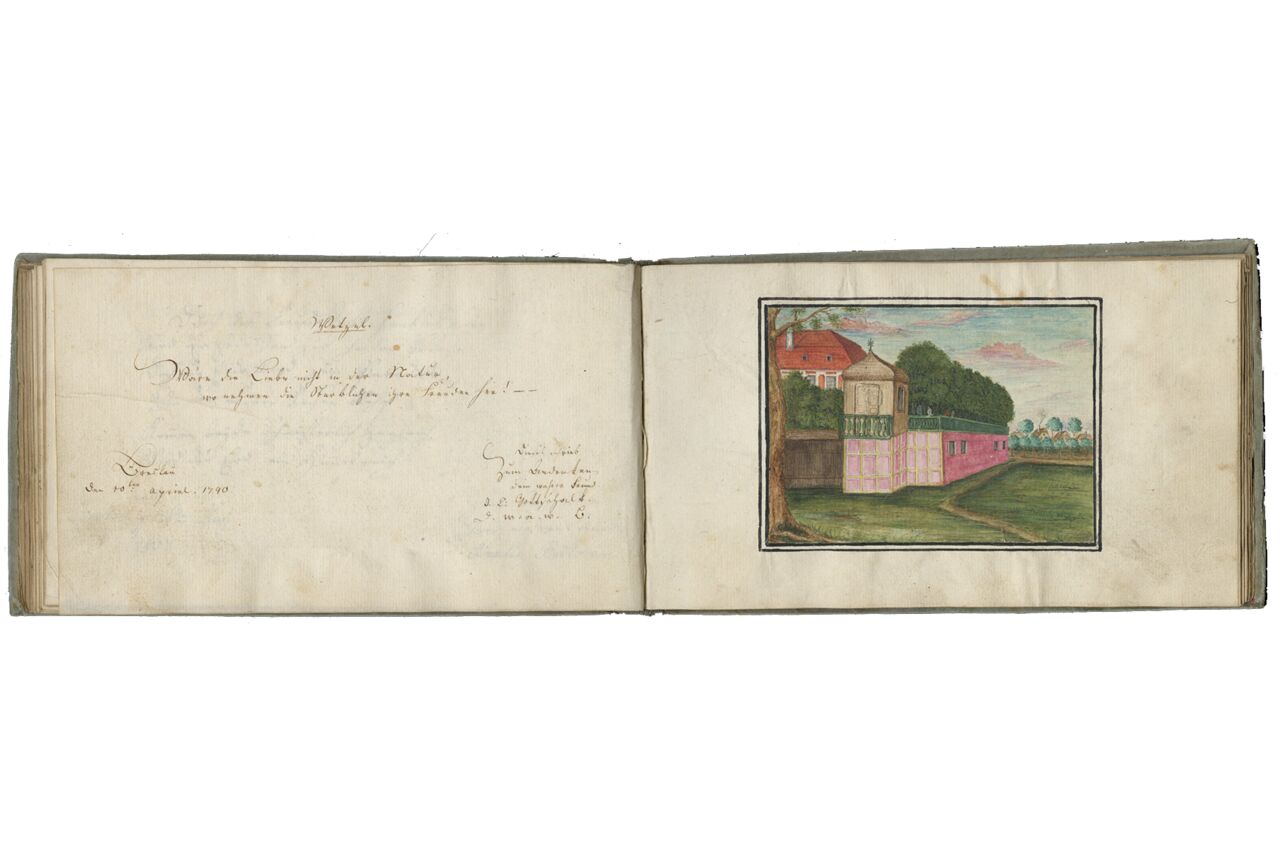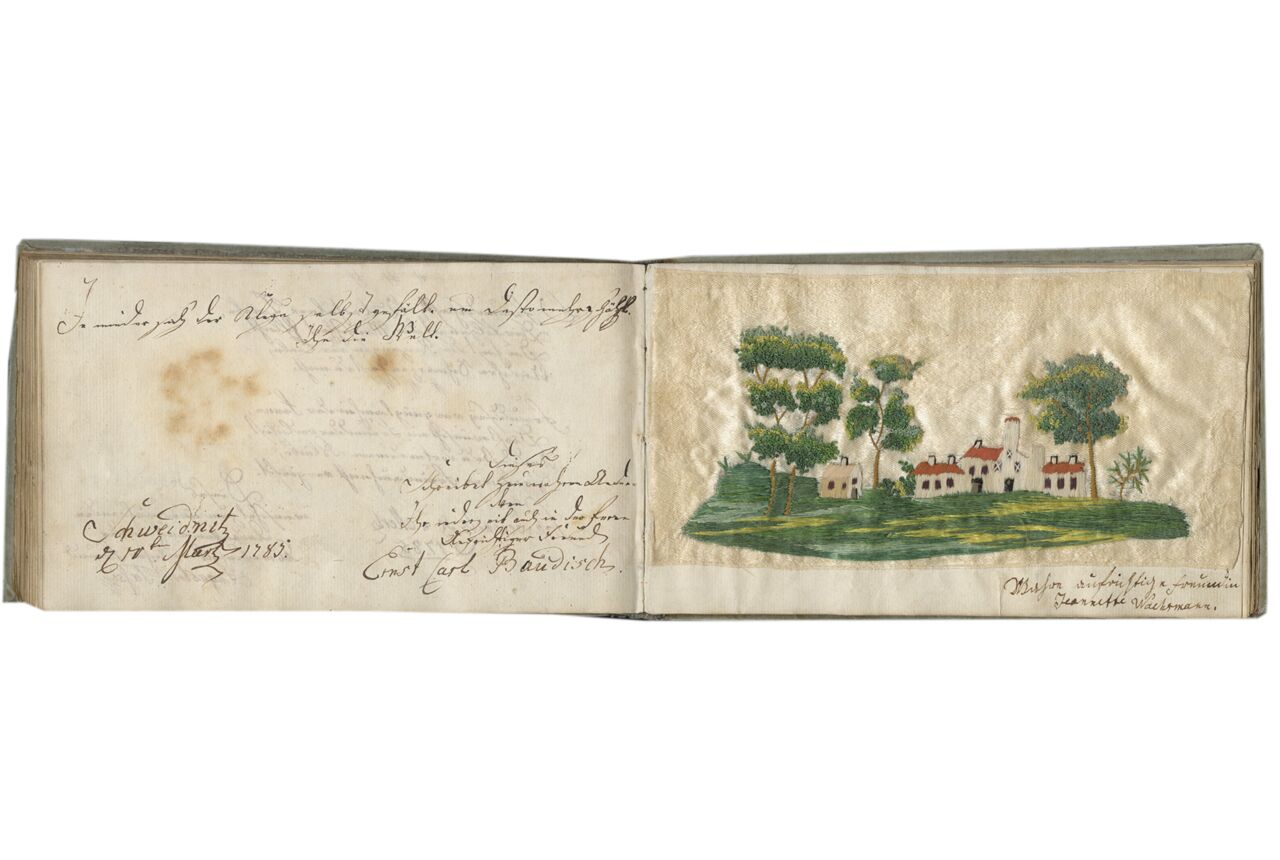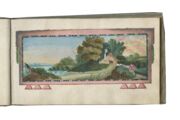iii + 76 folios on paper, watermark “Schweidnitz,” modern foliation in pencil, 1-76, SIX WATERCOLORS (and one fragment), ONE SILK EMBROIDERY, ONE SILHOUETTE PORTRAIT, f. 24 cut off almost entirely, some minor stains, in overall excellent condition. ORIGINAL BINDING of light blue silk over pasteboards, both covers decorated with a gilt stamped border of small flowers and arabesques, flat spine, gilt edges, hand-dyed endpapers and pastedowns, gold decoration very worn on the covers, binding detached on the spine in two places, silk stained especially on the back cover, otherwise in good condition. Dimensions 108 x 183 mm.
Alba Amicorum, the forerunners of the autograph album, offer us glimpses into social networking in earlier centuries. Each example is unique. This album, which belonged to Christian Gottlieb Rüdiger, contains fascinating entries by his medical colleagues, with whom he served as surgeon in the counter-revolutionary regiments led by the Swiss commander, von Erlach, and Prince Hohenlohe. It collects fifty souvenirs from his friends, many offered by women. Among the entries are especially fine illustrations, including a remarkable silk embroidery.
Provenance
1. This is the album amicorum of the surgeon, Christian Gottlieb Rüdiger, whose name is found on the titlepage on f. 1. The entries date between 1785 and 1806, in Breslau and Schweidnitz in Prussian Silesia (today southwestern Poland). Notably, the watermark informs that the paper for this album was made locally in Schweidnitz.
2. The manuscript belonged to Astrik Ladislas Gabriel (1907-2005), the Hungarian medievalist and Premonstratensian canon. His illustrated ex libris is found on the front pastedown; it shows a medieval scholar at a lectern, depicted below the arms of three of Gabriel’s universities: Pécs (in his native town in Hungary), Sorbonne (Paris) and Obuda (Budapest).
3. Booksellers’ notes on the verso of the first front flyleaf: “#35777” and “102”.
Text and Illustration
f. 1, [titlepage], Watercolor representing a sculpted pink marble coffer on the floor of a doctor’s study; a shield on the coffer is inscribed “Pour l’amitié. Christian Gottlieb Rüdiger. 1785”; against the coffer leans a serpent-entwined rod, the Rod of Asclepius, a deity associated with healing and medicine. The rod casts a brown shadow on the coffer. Illustrated herbals lie open on the floor and others are leaning against the coffer. On the right is a fascinating bookcase filled with imposing leather-bound tomes, as well as carefully depicted jars and flasks of all shapes and sizes containing various substances, specimens and concoctions. Two jars are labelled “litharge” and “myrrh”;
f. 22, Watercolor representing Asclepius, deity of medicine in ancient Greek mythology; he is represented in a landscape holding his serpent-entwined staff and in the company of one of his daughters (Hygieia?);
f. 24, [leaf was almost entirely removed]; Fragment of a watercolor illustration of a flower garland;
f. 26v, Very fine black shadow silhouette portrait of a young man enhanced in fine strokes drawn in silver and gold, within an oval frame decorated with a ribbon and a flower garland painted in watercolor;
f. 29, Watercolor representing a landscape with a house by a lake, a farmer with a flock of sheep, fields, forests and distant hills;
f. 38, Watercolor representing haymaking: a farmer rides a horse pulling a cart filled with hay on which is seated a lady in a pink dress ; in the foreground, another farmer leans on his staff or scythe next to sheaves of grain; the clouds in the sky are atmospherically colored by the evening sun;
f. 46, Watercolor representing a manor house surrounded by an elevated walled garden graced with an elegant gazebo and balustrade and peopled by promenading couples;
f. 58, Very fine silk embroidery by Jeannette Wachsmann representing a farm surrounded by large trees, mounted on the page;
f. 67, Watercolor by Dor. Beate Gräfer representing a young man walking in a landscape.
Other entries are by Schwartz, “Chirurgus im Erb-Printz zu Hohenlohschen Infanterie Regiment” (f. 3), Walter, “Chirurgus im Erb-Printz zu Hohenlohschen Infanterie Regiment” (f. 4), Amstetten (f. 5), Lange (f. 7v), S. Pletschke, “Oberchirurg zu Hohenlohe” (f. 12), L. H. D. Scha(?) (f. 16), Johann Friedrich Railler (f. 23v), Johann Gottlob G. (f. 27), Sophia Charlotte Haknern (f. 32), Josephe Wachsmann (f. 33v), Pitscher (f. 35), Jacoby (f. 36), Joh. Gott. Hausig (f. 38), D. Neigefind (f. 39), A. D. (f. 40), Friederike Kaiser (f. 43v), Amalie Prätorius (f. 44v), J. L. Gottschalk (f. 45v), C. F. and J. F. Wollgast (ff. 47v-48), Valentin Cagenias Ferdinand Müller (f. 49), Joh. Gottlieb Leukert (f. 51), F. M. Z. (f. 52), Daniel Turteltaube (f. 53), Chorny, “Compagnie Chirurgus des Regiments v. Erlach” (f. 54), E. H. Gallisch, “Regiment von Erlach” (f. 55), J. M. Scheübner (f. 56), Augustin Tassi (f. 57), Ernst Carl Baudisch (f. 57v), Jeannette Wachsmann (f. 58), E. G. C. K. (f. 59v), L. V.(?) (f. 62), C. B. (f. 63), von Koschitzky (f. 65), Dor. Beate Gräfer (f. 66v), G. E. Meywald (f. 68), J. O. V. S. (f. 70), Zielbauer (F. 71), Jacobi Cultor Vecon (f. 72), Jean Christian Gottschall (f. 73), Samuel Gottlob Scholz (f. 74), von Jülich, “Lieutenant im Regiment Erb. Prinz zu Hohenlohe” (f. 75), and Carl Martens (f. 76). Remaining pages are blank.
The entries offer information about Rüdiger’s life. The illustrated titlepage reveals his medical profession. He may be a descendant of his namesake Christian Gottlieb Rüdiger, baptized in 1729, a surgeon from Pomerania (on the shore of the Baltic Sea, today Poland and Germany), whose father was also a surgeon (Jahresbericht, 1902, p. 2). In 1785, our Rüdiger was probably working as a surgeon for the Regiment of Karl Ludwig von Erlach in Schweidnitz, as suggested by the numerous poems offered in the album to him by his surgeon colleagues there (see ff. 54, 55, etc. for Chorny, Gallisch, and others). In 1795, he was probably working as a surgeon for the Hohenlohe Regiment in Breslau (Online Resources); his colleagues in the Regiment, surgeons Schwartz, Walter and Pletschke, and lieutenant von Jülich, made entries for him on ff. 3, 4, 12, and 75 (among others). The entries in the album are mainly poems in German, written in neat, and often quite small, handwriting; a few entries are in French (such as the poems on ff. 59v and 73), and one is in Latin (f. 72). The illustrations include six fine watercolors, a ravishing silk embroidery and a very fine silhouette portrait enhanced with intricately drawn details.
The album amicorum, or album of friends, was typically compiled by young aristocrats, who collected entries from their circle of friends, professors, supporters, colleagues, relatives, and acquaintances during their travels and studies. Christian Gottlieb Rüdiger’s album provides original late eighteenth-century and early nineteenth-century material for studying social history in Prussian Silesia, offering insights into social networking within the aristocratic circles. Rüdiger’s profession, and the entries written by his colleagues who were also surgeons are of particular interest.
Throughout their history, friendship albums were often in an elongated horizontal format, as in the case for our manuscript. The album amicorum is central to modern transdisciplinary research into texts, reception, and collecting in cultural and social contexts, as well as studies in the history of mentalities; see especially the comprehensive study by Werner Wilhelm Schnabel published in 2003, and the Online Database, “Repertorium Alborum Amicorum” (Online Resources).
Literature
Fechner, J.-U. ed. Stammbücher als kulturhistorische Quellen, Wolfenbütteler Forschungen 11, Munich, 1981.
Jahresbericht des Königlichen Fürstin-Hedwig-Gymnasiums zu Neustettin über das Schuljahr 1901, 262tes der Anstalt, Neustettin, 1902.
Keil, R. and R. Die deutschen Stammbücher des sechzehnten bis neunzehnten Jahrhunderts. Ernst und Scherz, Weisheit und Schwank in Original-Mittheilungen zur deutschen Kultur-Geschichte, Berlin, 1893 (reprint Hildesheim, 1975).
Klose, W. “Stammbücher: eine kulturhistorische Betrachtung,” Bibliothek und Wissenschaft 16 (1982), pp. 41-67.
Kurras, L. Zu gutem Gedenken. Kulturhistorische Miniaturen aus Stammbüchern des Germanischen Nationalmuseums 1570-1770, Munich, 1987.
Lilienthal, M. Schediasma critico-literarium de philiothecis varioque earundum usu et abusu, vulgo von Stamm-Büchern, Königsberg, 1712; rev. Wittenberg, 1740 (repr. in Fechner, 1981, pp. 237-298). [the first study of Alba Amicorum].
Nickson, M.A.E. Early Autograph Albums in the British Museum, London, Trustees of the British Museum, 1970.
Rosenheim, M. The album amicorum, Oxford, 1910.
Schnabel, W. W. Das Stammbuch: Konstitution und Geschichte einer textsortenbezogenen Sammelform bis ins erste Drittel des 18. Jahrhunderts, Berlin, 2003.
Schünemann, H. “Stammbücher,” Schrifttumsberichte zur Genealogie und zu ihren Nachbargebieten 2 (1965), pp. 67-108.
Taegert, W. Edler Schatzholden Erinnerns: Bilder in Stammbüchern der Staatsbibliothek Bamberg aus vier Jahrhunderten, Bamberg, 1995.
Thomassen, K. ed. Alba amicorum. Vijf eeuwen vriendscap op papier gezet. Het album amicorum en het poëziealbum in de Nederlanden, Maarssen/The Hague, 1990.
Online Resources
“Repertorium Alborum Amicorum” https://raa.gf-franken.de/de/startseite.html
Our manuscript,
https://raa.gf-franken.de/de/suche-nach-stammbuechern.html?permaLink=1785_ruediger
Hohenlohe Regiment
https://fr.wikipedia.org/wiki/R%C3%A9giment_Hohenlohe_(Arm%C3%A9e_des_%C3%A9migr%C3%A9s)
Ludwig Aloysius Joachim, Prince of Hohenlohe-Waldenburg-Bartenstein https://fr.wikipedia.org/wiki/Louis_Alo%C3%BFs_de_Hohenlohe-Waldenbourg-Bartenstein
Karl Ludwig von Erlach https://en.wikipedia.org/wiki/Karl_Ludwig_von_Erlach
TM 1309


